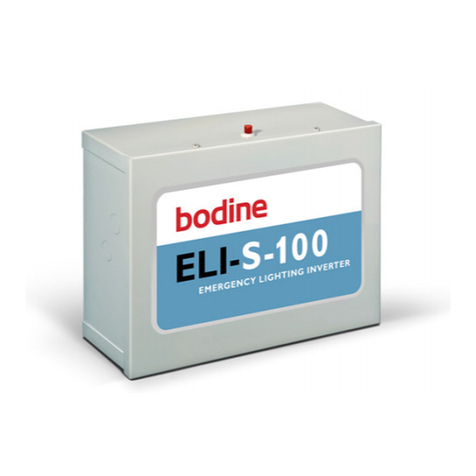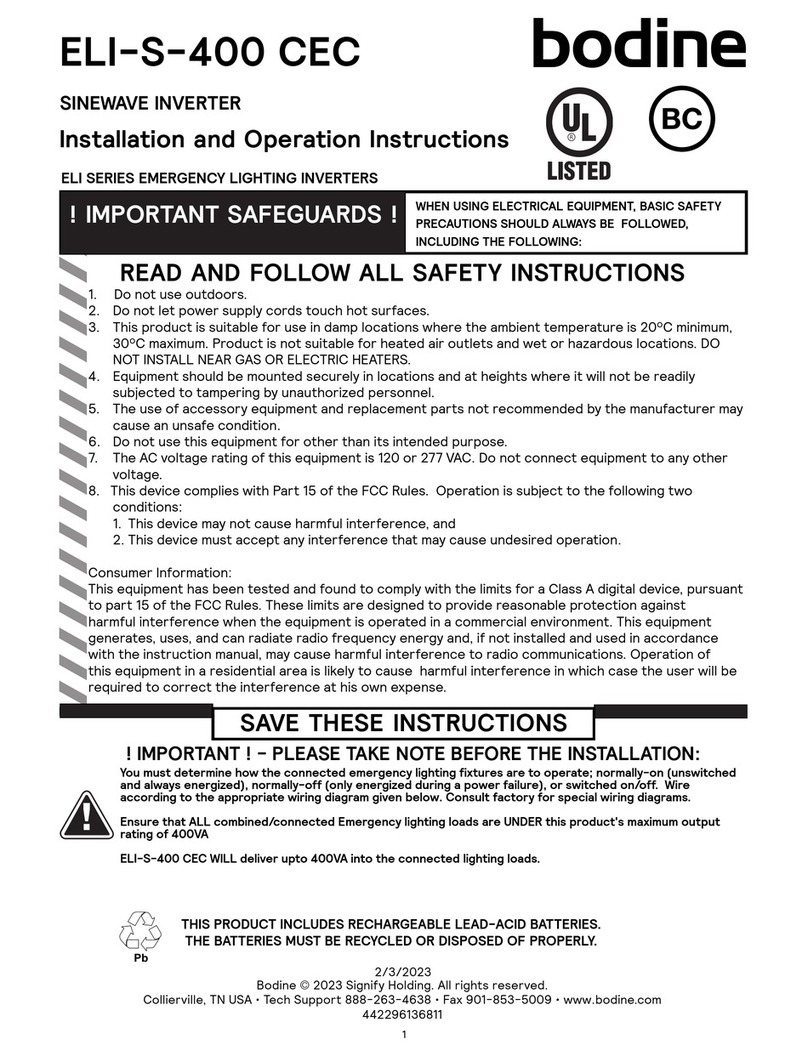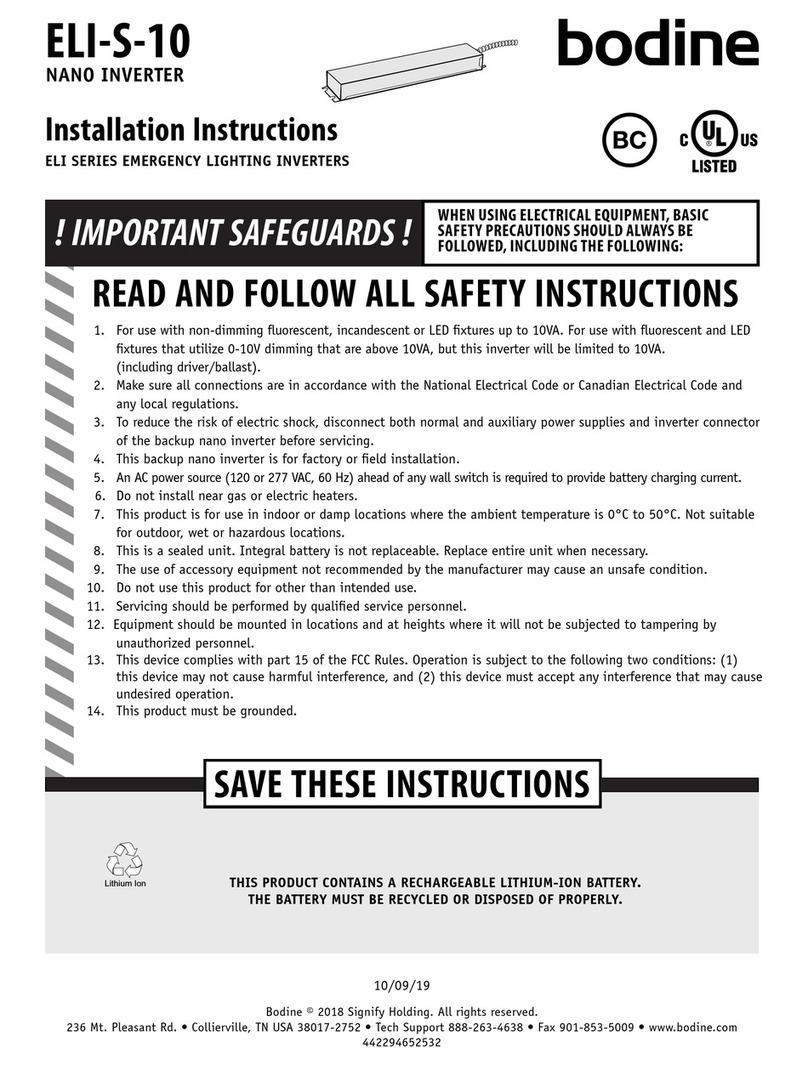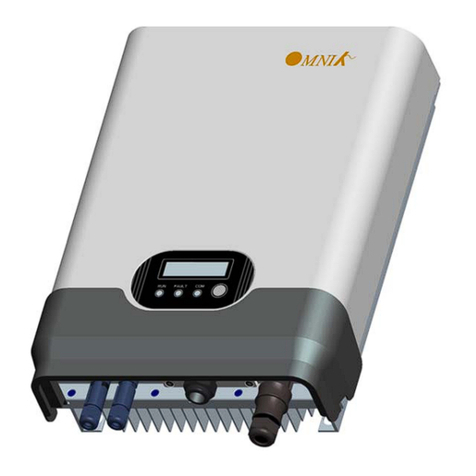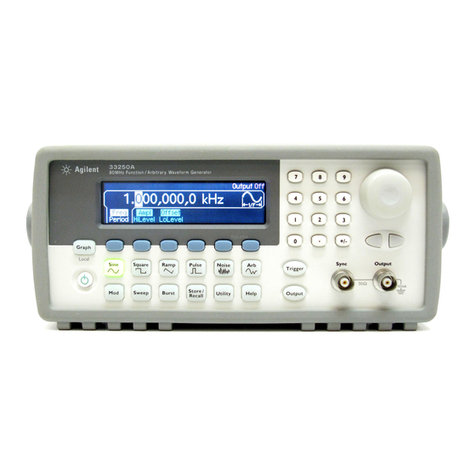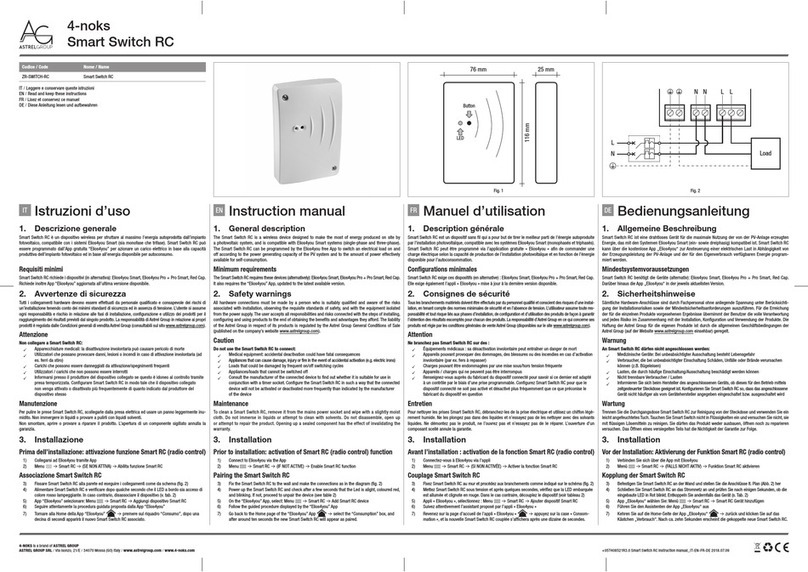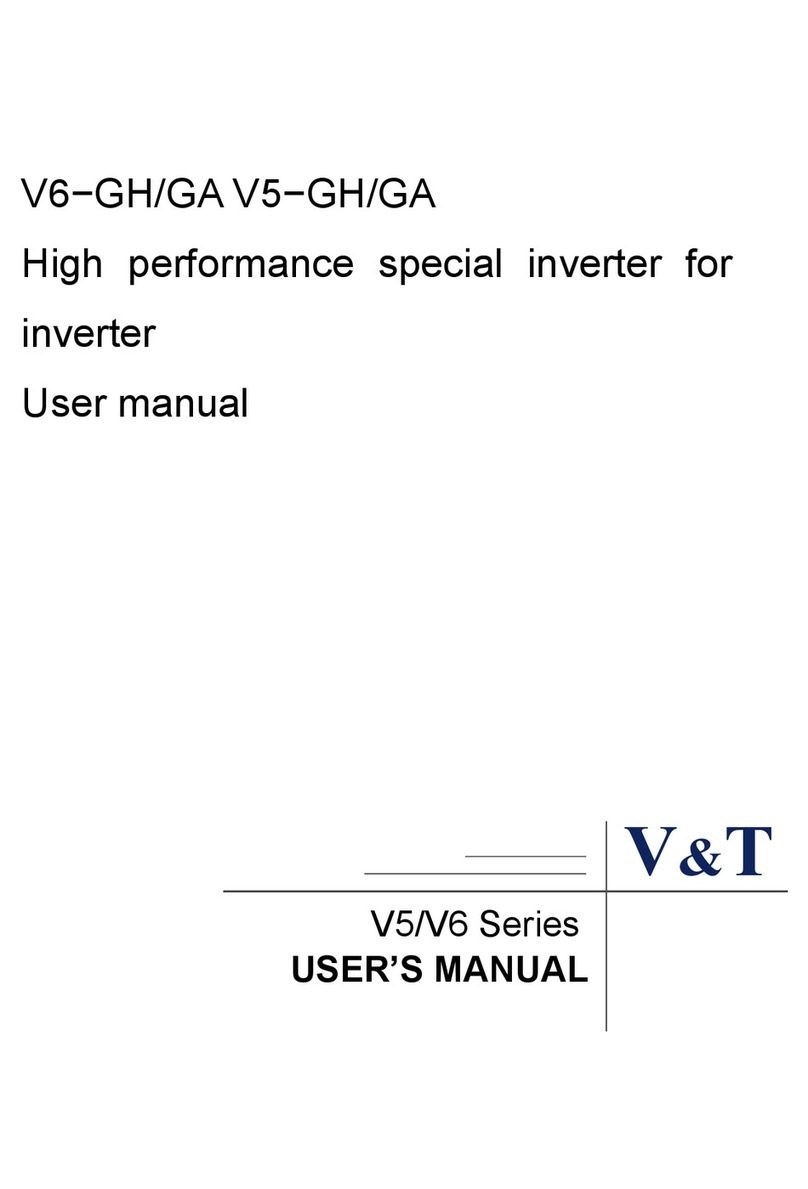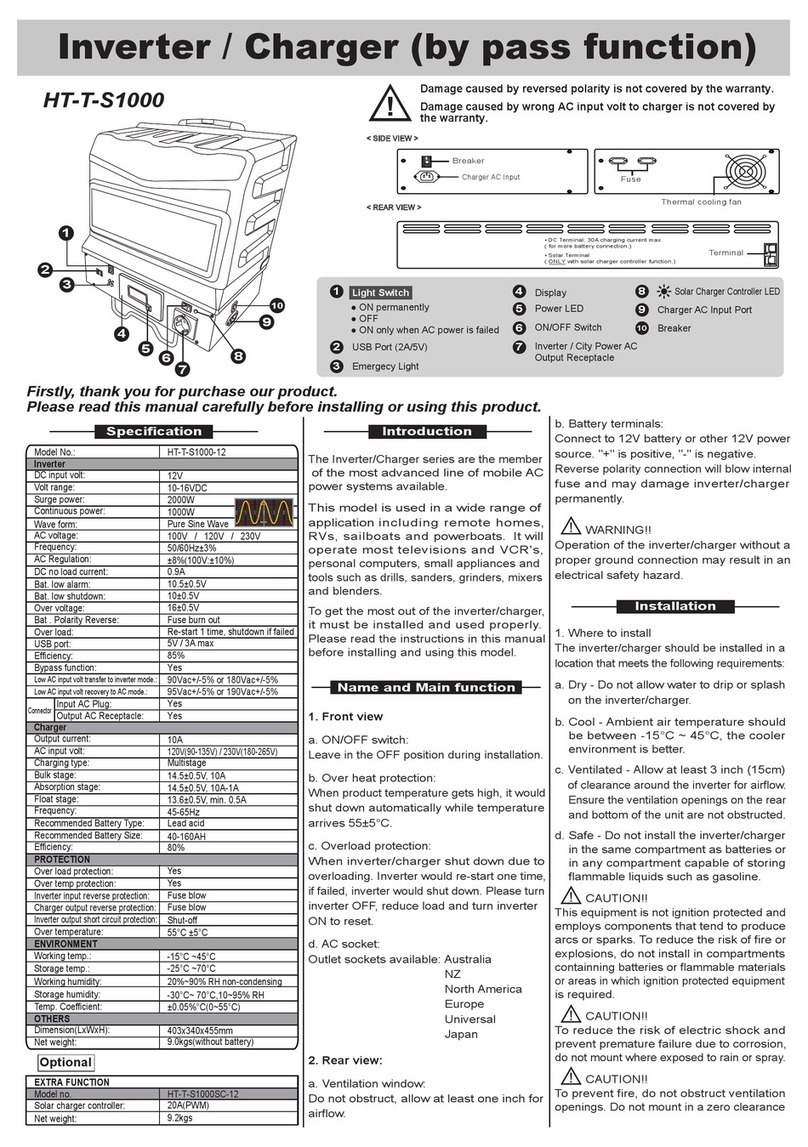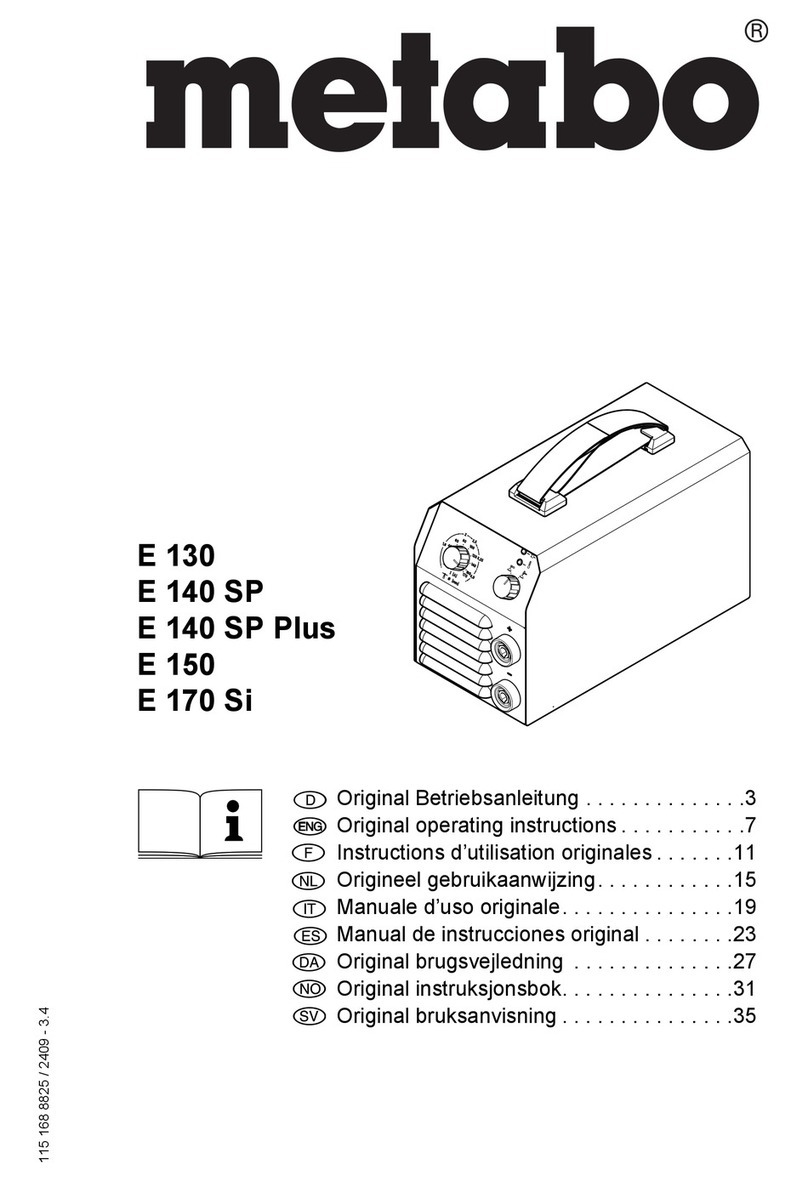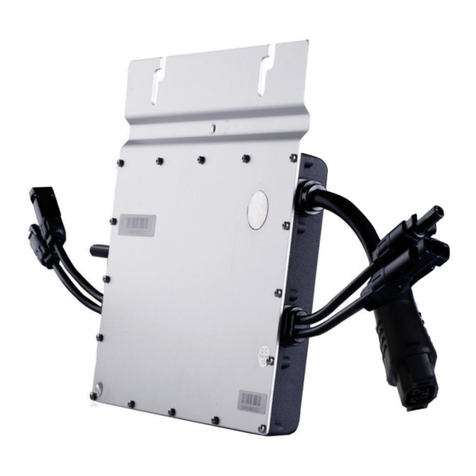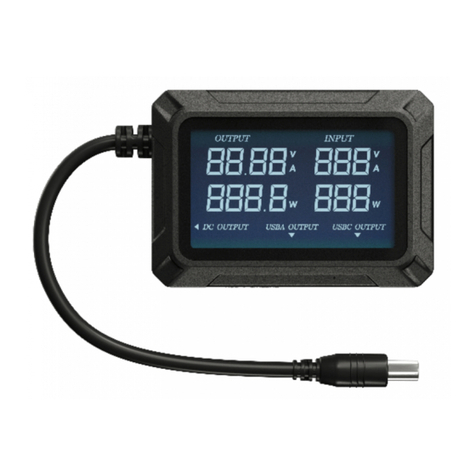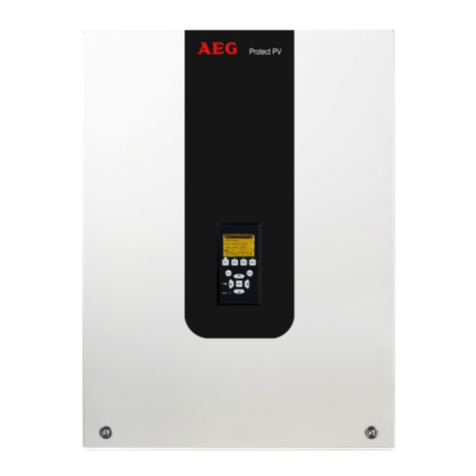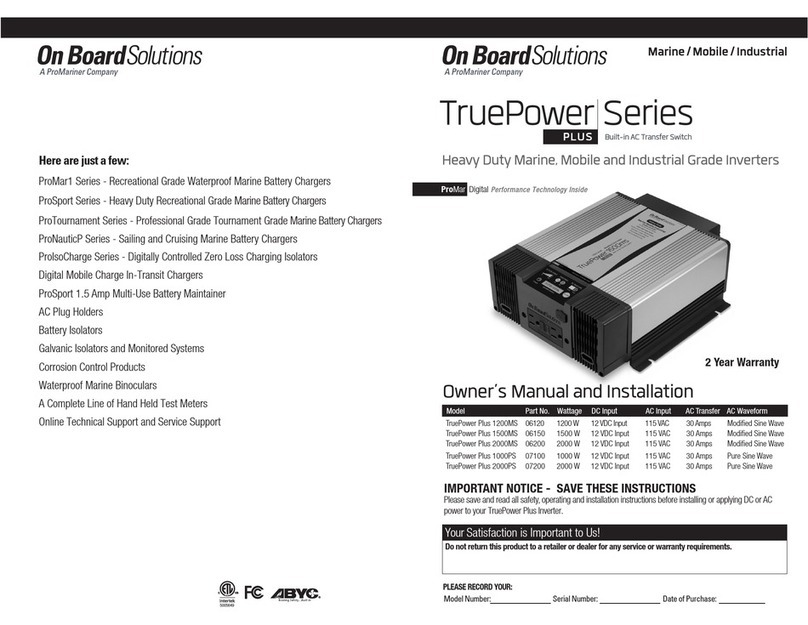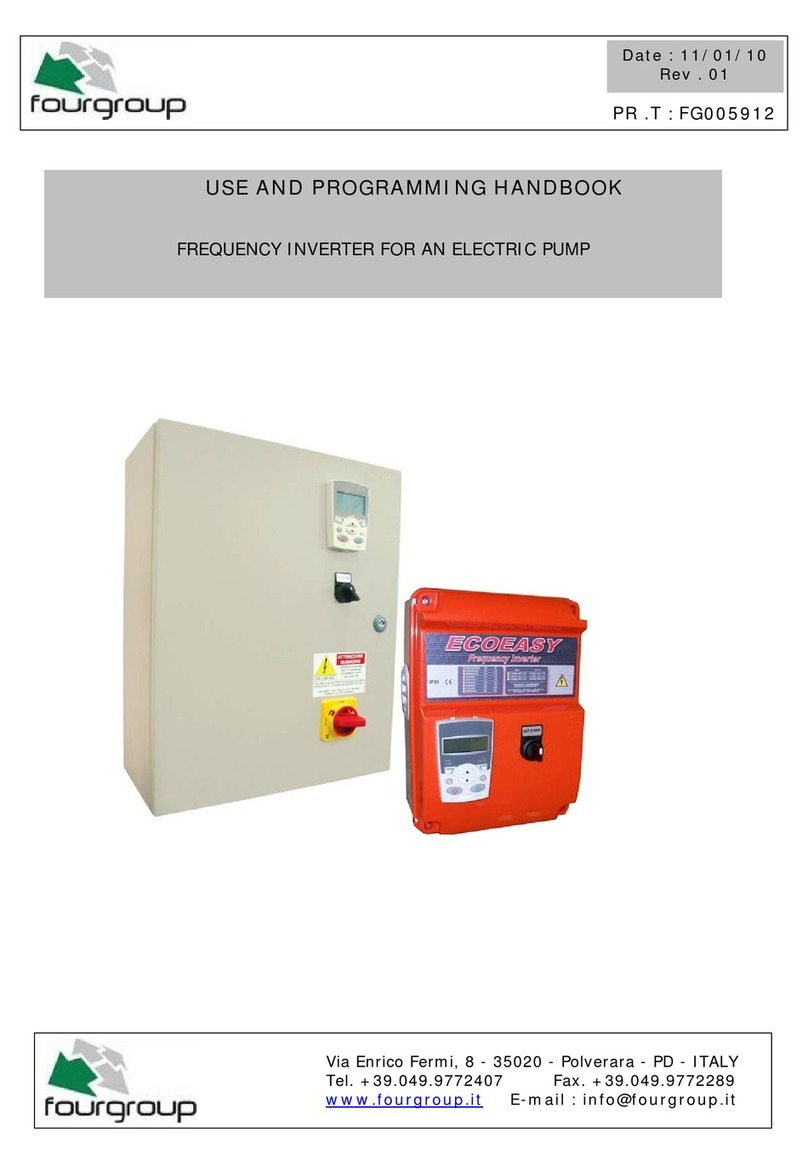Bodine ELI Series Owner's manual

READ AND FOLLOW ALL SAFETY INSTRUCTIONS
! IMPORTANT SAFEGUARDS ! WHEN USING ELECTRICAL EQUIPMENT, BASIC SAFETY
PRECAUTIONS SHOULD ALWAYS BE FOLLOWED,
INCLUDING THE FOLLOWING:
SAVE THESE INSTRUCTIONS
1. Do not use outdoors.
2. Do not let power supply cords touch hot surfaces.
3. This product is suitable for use in damp locations where the ambient temperature is 20ºC minimum, 30ºC maximum.
Product is not suitable for heated air outlets and wet or hazardous locations. DO NOT INSTALL NEAR GAS OR
ELECTRIC HEATERS.
4. Equipment should be mounted securely in locations and at heights where it will not be readily subjected to
tampering by unauthorized personnel.
5. The use of accessory equipment and replacement parts not recommended by the manufacturer may cause an unsafe
condition.
6. Do not use this equipment for other than its intended purpose.
7. The AC voltage rating of this equipment is 120 or 277 VAC. Do not connect equipment to any other voltage.
8. This device complies with Part 15 of the FCC Rules. Operation is subject to the following two conditions:
(1) This device may not cause harmful interference, and
(2) This device must accept any interference that may cause undesired operation.
Consumer Information :
This equipment has been tested and found to comply with the limits for a Class A digital device, pursuant to part 15 of the FCC Rules.
These limits are designed to provide reasonable protection against harmful interference when the equipment is operated in a commer-
cial environment. This equipment generates, uses, and can radiate radio frequency energy and, if not installed and used in accordance
with the instruction manual, may cause harmful interference to radio communications. Operation of this equipment in a residential
area is likely to cause harmful interference in which case the user will be required to correct the interference at his own expense.
You must determine how the connected emergency lighting fixtures are to operate; normally-on (unswitched and
always energized), normally-off (only energized during a power failure), or switched on/off. Wire according to the
appropriate wiring diagram given below. Consult factory for special wiring diagrams.
Ensure that ALL combined/connected Emergency lighting loads OVER this product's maximum emergency output
rating (250 VA or 185 VA, depending on the model) are capable of being dimmed down to a power output of 10%
from an industry standard 0-10V source.
ELI-S-250 WILL ONLY deliver 250 VA and the ELI-S-185 WILL ONLY deliver 185 VA into the lighting load. This is
accomplished by automatically dimming the connected emergency lighting loads down to the products output power
rating.
Pb
THIS PRODUCT INCLUDES RECHARGEABLE LEAD-ACID BATTERIES.
THE BATTERIES MUST BE RECYCLED OR DISPOSED OF PROPERLY.
! IMPORTANT ! PLEASE TAKE NOTE BEFORE THE INSTALLATION:
Installation and Operation Instructions
ELI SERIES EMERGENCY LIGHTING INVERTERS
BC
ELI-S-250 &
Bodine © 2022 Signify Holding. All rights reserved.
Collierville, TN USA • Tech Support 888-263-4638 • Fax 901-853-5009 • www.bodine.com
442295564161
7/8/2022
SELF-TESTING SINEWAVE INVERTER
ELI-S-185 2-Hour

2
ILLUSTRATION 1
CIRCUIT BOARD INSTALLATION QUICK REFERENCE
BATTERY FUSE
30A/32VDC
FAST ACTING
OFF
ON
OFF
ON
SW-1
OUTPUT
ENABLE
Chassis Ground Wire
CASE
GND
TEST SWITCH
ON COVER
Battery Cables
X5 and X6
CIRCUIT BOARD COMPONENT LOCATION DIAGRAM SHOWING CONNECTION POINTS
TB-2
LINE
OUTPUT
OUT
COM
OUT
HOT
120Vac or 277Vac
TO LIGHTING LOAD
OUTPUT INVERTER
ON / OFF SWITCH
0-10V DIMMING OUTPUT WIRES
FROM X3-1 AND X3-2
TO CONNECTED LIGHTING LOAD(S)
120Vac or 277Vac
INPUTS
0-10V ROOM
DIMMING WIRES
TO X3-3 AND X3-4
TB-1
LINE
INPUTS
DIM
OUT
DIM
IN
FGND
UNSW
HOT
COM
SW
HOT
FGND
UNSW
HOT
COM
SW
HOT
- + + -
X3
Model Input
Voltage
Output
Voltage
(Autoselect)
Emergency Output
Power
Max Connected
AC Load* Emergency Run Time
ELI-S-250 120/277Vac 120/277Vac 250 VA 800 VA Minimum of 90 minutes
ELI-S-185 120/277Vac 120/277Vac 185 VA 800 VA Minimum of 120 minutes
MODEL SPECIFIC OUTPUT RATINGS
* NOTE: AC Input Power to an LED or Fluorescent Driver/Ballast is always more than the output power. Furthermore, dim-
ming drivers are less efficient at reduced power. These inefficiencies must be accounted for in the design as they will likely
reduce the maximum connected load to something less than 800W. As a typical rule of thumb, provide at least 10% margin
whenever the load specifics are not well known.
INSTALLATION
Illustration 1, below, shows the inverter's main circuit board. This circuit board contains the enable switch, fuse, and wir-
ing terminals. Approximate locations of these items are given in Illustration 1 along with details of their use. Reference
this diagram for the remainder of the installation instructions.
STEP #1 INSTALLING THE EMERGENCY LIGHTING SYSTEM
> Remove front cover, circuit board tray, and any packing material inside the unit housing that may have been used for ship-
ping purposes.
> Secure housing to the mounting surface through the keyhole knockouts using mounting hardware (not supplied). This
hardware must be appropriate to hold the unit weight of approximately 70 lbs. with the batteries installed.
> Remove the knockouts to install input, output, and optional 0-10V dimming wiring conduit fittings.
> Extend AC supply wiring, output load wiring, and dimming control wiring into the equipment enclosure using appropriate
wiring hardware and methods.
> Illustration 1 details the locations of the various wiring terminals needed for the remainder of the installation. Reference
Illustration 1 for steps through 2 through 5.

STEP #3
Reference Illustration 1, 3A, 3B, and 3C when making the following wiring connections.
> Loop the load wires the once through the ferrite core (Illustration 3A)
> Connect the Load Common lead to screw terminal TB-2 “OUT COM” (Illustration 1)
> Connect the Load Hot lead to screw terminal TB-2 “OUT HOT” (Illustration 1)
> Loop all input wires once through another Ferrite core (Illustration 3B)
> Connect the Emergency Lighting Inverter to ground using screw terminal TB-1 “FGND” (Illustration 1)
> Connect the AC Power Source Common to screw terminal TB-1 “COM” (Illustration 1)
> Loop test switch wire once through another Ferrite core. (Illustration 3C)
> Temporarily connect the test switch to X2 for installation verification purposes. The test switch will be finally installed in the
enclosure lid in step 6. (Illustration 1)
> Connect the Un-switched Hot input to screw terminal TB-1 “UWSW HOT” (Illustration 1)
> Connect the Wall switch hot wire to screw terminal TB-1 “SW HOT”. This is the means of powering the load luminaires in Normal
Mode when a wall switch is used to turn these luminaires on and off. If no wall switch is used, and the load luminaires are
controlled by the same circuit breaker that is powering the un-switched hot. In this case TB-1 “SW HOT” must be jumpered to
TB-1 “UWSW HOT”. (Illustration 1)
WIRING THE EMERGENCY LIGHTING INVERTER’S PRIMARY POWER CONNECTIONS
NOTE: Make sure all connections are in accordance with the National Electrical Code, Canadian Electrical Code and any local regulations.
• Ensure input and output primary wiring connections are made to the proper terminals. Damage to
product may occur if miswired.
• Ensure load voltage requirements match the output ratings of this product or damage to the load
devices may occur.
CAUTION
STEP #2 BATTERY INSTALLATION AND CABLE CONNECTION
This product is provided with two sealed lead-acid batteries. Only the batteries supplied by the inverter manufacturer
should be used. Install the batteries as shown, referring to Illustrations 2A and 2B.
With the unit secured to the mounting surface, begin installation by sliding the batteries into the enclosure. Connect
the battery cables using the supplied hardware. The batteries must be connected using the provided battery connection
wires. Insert the bolt into the lock-washer first, then through the retaining washer, the battery cable's ring terminal, and
finally into the threaded hole in the battery terminal (observing proper polarity by matching the cable color to the bat-
tery terminal color). Tighten to no more than 4 Ft/Lbs torque. Cover the main harness terminals with the rubber terminal
cover to protect against accidental short circuits. Open the ferrite core and pass the red and black battery connector wires
through and close (Illustration 2B). Connect the battery jumper cable last.
CAUTION: DO NOT CONNECT the battery cables to Circuit Board connector X5 until the unit is ready for
use. The batteries WILL BE discharged after long periods of unit inactivity while connected to the circuit
board. If this occurs, the batteries will require at least 24 hours to recover before they can be used for
emergency service. If left in this discharged state for extended periods, the batteries may be damaged.
Illustration 2A Illustration 2B
RED
BLACK
JUMPER (BLACK)
BATTERY
TERMINAL
BOLT
LOCK WASHER
RING
TERMINAL
RETAINING WASHER
RUBBER TERMINAL COVER
Illustration 3C
Test Switch Indicator
Illustration 3B
Input Wires
Illustration 3A
Output Load Wires
3
RED
BLACK
JUMPER (BLACK)
FERRITE
CORE

STEP #5 ENABLE THE INVERTER AND APPLY AC POWER
> After installation is complete, and after the building power commissioning has been completed,
apply AC mains power and then turn on SW-1 on the ELI-S-250 Circuit board.
NOTE: The ELI-S-250 & ELI-S-185 features a “power commission lockout” that prevents the inverter from operating in the
Emergency Mode unless charging power (UNSW HOT) has been applied AFTER the batteries are connected.
> At this point, the Charging Indicator Light on the test switch should illuminate indicating the battery is charging.
> A short-term discharge test may be conducted after the Emergency Lighting Inverter has been charging for 12 hours.
Charge for 24 hours before conducting a long-term discharge test. Refer to OPERATION for details.
4
STEP #4 WIRING THE EMERGENCY LIGHTING INVERTER’S DIMMING CONNECTIONS (OPTIONAL)
This product features an industry-standard 0-10V dimming voltage output. Existing area dimming controls can be wired
through the product's dimming relay to allow for normal dimming by occupants of the area during Normal mode opera-
tion. The X3 connector accepts wire size # 24 AWG to # 16 AWG. Refer to Illustration 1.
Normal Operation: AC power is supplied to the AC ballast/AC LED drivers within the connected luminaires through the SW HOT
input. The batteries are charged from power supplied to the UNSW HOT input. Turning on SW-1 on the circuit board supplies
power to the control/monitor circuit and enables the Emergency Lighting Inverter. Dimming control, if used, are passed through
the unit to the connected loads.
Emergency Mode Operation and Dimming: Immediately after an AC power failure the Emergency Lighting Inverter applies back-up
power to the connected loads and outputs a minimum DC voltage on the 0 – 10V dimming supply. This causes the dimmable
connected loads to start out at minimum light output and consequently, minimum power draw. The ELI-S-250 & ELI-S-185
rapidly increases the 0 – 10V dimming voltage until the output power provided by the inverter reaches the products maximum
emergency mode power into the connected load(s). This is referred to as Auto-Dimming. When AC power is restored, the
ELI-S-250 & ELI-S-185 returns to normal charging mode. The ELI-S-250 operates the emergency lighting load for a minimum of
90 minutes. The ELI-S-185 operates the emergency lighting load for a minimum of 120 minutes.
NOTE: Driver efficiency and power factor typically fall as dimming level decreases which must be taken into account when
using the Auto-Dimming feature. This may reduce the maximum AC load connected. Contact the factory with any questions.
Self-Test: This product contains self-testing functionality. Self-test will automatically perform a 30-second test each month and
a full duration test once per year (90 or 120 minutes, depending on the model). During this automatic test, the product will
perform diagnostics on the battery, the battery charger, the load transfer circuitry, and the load. Any failures will be indicated
by flashing of the charge indicator LED built into the illuminated test switch. This flashing will continue until either the
condition has been corrected and the unit reset OR the next scheduled test has been run successfully.
Load Monitoring / Commissioning: This product complies with the latest UL standard for emergency lighting, UL 924, and includes
the required load change detection circuit for use when performing the diagnostic self-test routine. When first energized, the
product will automatically perform a 30-second commissioning test to detect the connected emergency lighting load level.
This load level is stored in the product's internal memory. During future tests or outages, the load level will be checked and
compared against this value. If the load level deviates by more than 10%, the product will send an error code through flashing
of the charge indicator LED. The inverter WILL continue to attempt to provide emergency power, regardless of error status.
OPERATION
STEP #6 INSTALLATION OF ENCLOSURE LID
> Remove clip-nuts (X4) from accessory kit.
> Press on to chassis flanges, over lid mounting holes.
> Install the test switch through the hole in the lid.
> Reconnect the test switch to the PCBA.
> Place lid onto unit chassis.
> Install 8-32 screws in lid, through clip nuts(x4).
Clip Locations (x4)

5
! REFER ANY SERVICING TO QUALIFIED PERSONNEL !
MAINTENANCE & TROUBLESHOOTING
Always turn off SW-1(first), then turn off AC power to the equipment inside the case before
servicing.
Servicing should be performed only by qualified service technicians. Use only manufacturer supplied
replacement parts. Although no routine maintenance is required to keep this emergency lighting inverter
functional, it should be checked periodically to ensure that it is working.
1. Automatic self-testing performs a 30-second test once every month and a 90 minute or 120-minute test (depending on
model) once per year. A failure during this test will cause the charge indicator LED to flash with a code indicating the
failure type.
2. Visually inspect the charging indicator light monthly. It should be steadily illuminated. If flashing, use the table below
to determine the failure mode and follow the troubleshooting steps.
If manual testing is desired, the illuminated test switch on the product cover can be used to send the product into three
different test modes. These modes are detailed in the table below.
TESTING
WARNING:
Test Type Procedure to Follow Description
Manual Test Press and Hold the Test Switch
Initiates the emergency mode for as long as the switch is depressed. During the manual
test the emergency lighting load will turn off momentarily (if switched power is present).
After a few seconds, the lights will turn back on in the emergency mode. Releasing the
test switch will return the emergency lighting load to the normal AC mode.
Manual 30-Second Test Press and Release the Test Switch
Two Times
Manually initiates a 30-second diagnostic test. The inverter will switch to the emergency
mode for 30 seconds and test all relevant functions. Once complete, the inverter returns
to normal AC mode and indicate any faults, if detected.
Commissioning Test Press and Release the Test Switch
Three Times
Initiates a 30-second commissioning test. The inverter will switch to the emergency
mode and store in its memory the current connected load level. If, during future self-
tests, this load level deviates by more than 10%, an error will be triggered.
TEST SWITCH MODES
Trouble State or Indica-
tor Light Status Error Corrective Action
Indicator Light On Steady None • No Action. The product is operating correctly.
Indicator Light Off No Unswitched AC Mains Present
• Unit maybe operating in emergency mode only and there is no error
• Check unswitched hot wiring connections.
• Ensure unswitched hot circuit breaker is on.
• Ensure switch SW-1 is on.
1x Flashes Load Control (Transfer) Fault
• Check output voltage if it is within the spec
• Check if output load is connected properly
• Check output voltage is functioning
• If all the above conditions check OK, replace unit.
2x Flashes Battery Fault • Charge battery. If after an hour failure is still indicated, see battery action below.
3x Flashes Battery Disconnected or Charge Current Fault
• Ensure input wiring is correct and verify voltage is correct and stable.
• Check battery voltage and ensure battery is connect fully.
4x Flashes Load Level Change Greater Than 10%
• Ensure proper operation of all connected loads. If all functional, recommission the
inverter's load level detection (see Commissioning Test).
Continuous Flashing Commissioning Required • Follow instructions above to initiate the commissioning test.
TROUBLESHOOTING

6
Model Accessories Replacement Batteries
Installation Kit Battery Harnesses Fuse Part No. Quantity
ELI-S-250 & 185 PRT00143 PRT00144 Littlefuse 0312030 PRT00141 1 Required
Battery Maintenance: The batteries supplied with this equipment require no maintenance. However, the inverter should be
tested periodically, and batteries replaced whenever they will no longer operate the connected fixtures for the rated run-
time. The batteries supplied have a life expectancy of four years when used in normal ambient temperature of 72 degrees F.
Battery Date Code: The battery date code is made up of six characters which represent the month, day and year of manufacture (MM/
DD/YY). For example, 080221 means the battery was made August 2, 2021. There may be additional alpha-numeric characters at the
end of the date code. The date code is located on the battery carton and additionally engraved into the battery.
Battery Replacement: When replacing batteries, use only batteries supplied by the inverter manufacturer. The old batteries
should be disposed of properly or recycled in accordance with your local regulations. When replacing the batteries, follow
the process outlined in Installation Step #4 and #5 and the cautions and warnings given in these instructions. During
replacement, disable SW-1 on the inverter, then remove AC power from the product.
Fuse: The fuse contained within this product is field replaceable. For the battery fuse location see illustration 1. To replace
the fuse, disable SW-1 on the inverter then, remove AC power from the product. Ensure that the battery fuse F101 is replaced
by Littelfuse 0312030 (312-030) or equivalent 3AG, 30 A, 32 VDC.
REPLACEMENT PARTS
WIRING DIAGRAM
DIMMABLE EMERGENCY LIGHTING SYSTEM
Normal only
Luminaire
Normal only
Luminaire
Normal only
Luminaire
Normal only
Luminaire
Norm/Emer
Luminaire
Norm/Emer
Luminaire
Norm/Emer
Luminaire
Norm/Emer
Luminaire
120 or 277 VAC
Out HOT
Out COM
DIM OUT +
DIM OUT -
120 or 277 V
AC
Wall Switch
INVERTER
SW-1
Inverter ON / OFF
FGND
UNSW HOT
COM (Neutral)
SW HOT
{
TOTAL DIMMABLE POWER
UP TO 800W
From 0 - 10V
Room Dimmer
DIM IN +
DIM IN -
ANY QUANTITY SUPPORTED BY
THE BRANCH CIRCUIT
FIGURE W1
Figure W1 shows an example of a branch circuit powering a number of dimmable luminaires, 4 (or more) of which
are powered through the Emergency Lighting Inverter. During normal AC power mode, the power from the switched
hot lighting power and 0-10V room-dimmer voltage is passed through the Inverter to the “Normal/Emergency”
fixtures. The unswitched hot charges the battery. During a power failure, the Inverter powers the “Normal/
Emergency” fixtures for a minimum of the products rated runtime at a power level set by the Inverter’s dimming
output circuit. In any example, the dimmable “Normal/Emergency” luminaires are automatically limited to only
draw a total maximum of 250 VA from the ELI-S-250 during an emergency event.

Figure W2, shows an example of an alternate emergency lighting system in which the emergency luminaires ARE
NOT dimmable. In this case, the total connected Emergency lighting load MUST BE LESS THAN or EQUAL to the
Inverter's maximum output power.
FIGURE W2
7
Normal only
Luminaire
Normal only
Luminaire
Normal only
Luminaire
Normal only
Luminaire
Norm/Emer
Luminaire
Norm/Emer
Luminaire
Norm/Emer
Luminaire
Norm/Emer
Luminaire
120 or 277 VAC
Out HOT
Out COM
120 or 277 VAC
Wall Switch
SW-1
Inverter ON / OFF
FGND
UNSW HOT
COM (Neutral)
SW HOT
TOTAL POWER
= 250W
INVERTER
ANY QUANTITY SUPPORTED
BY THE BRANCH CIRCUIT
Non-DIMMABLE EMERGENCY LIGHTING SYSTEM
This manual suits for next models
3
Table of contents
Other Bodine Inverter manuals
Popular Inverter manuals by other brands
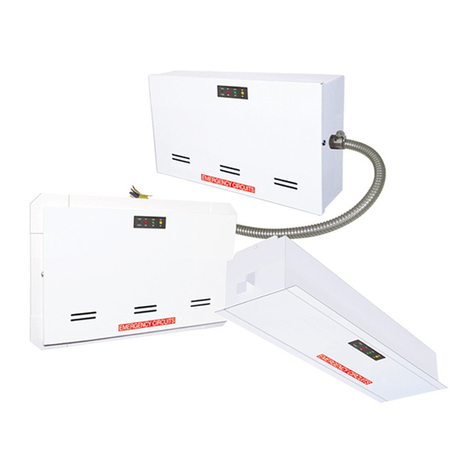
BARRON
BARRON EXITRONIX Tucson Micro Series installation instructions
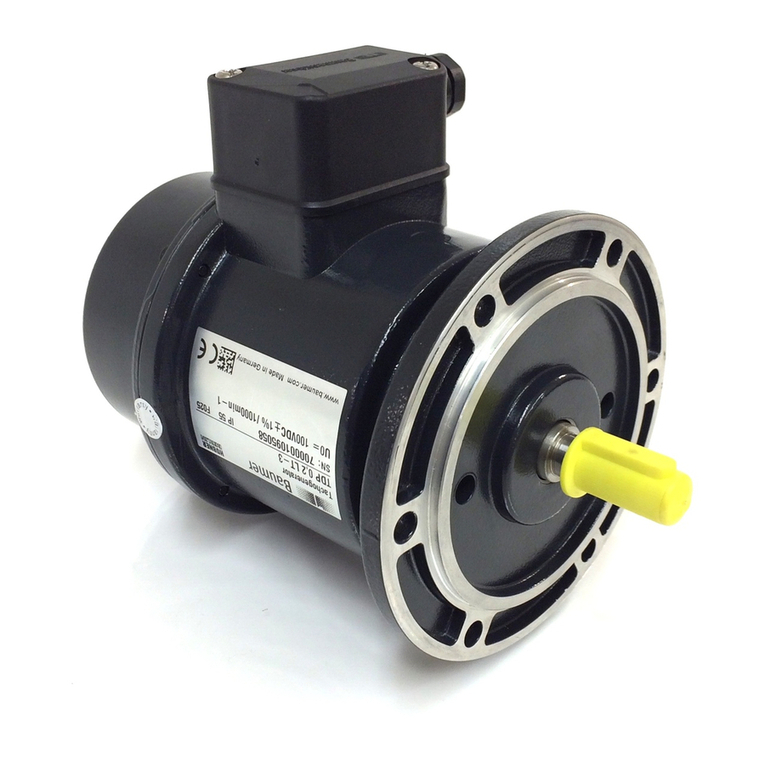
Baumer
Baumer HUBNER TDP 0,2 Series Mounting and operating instructions
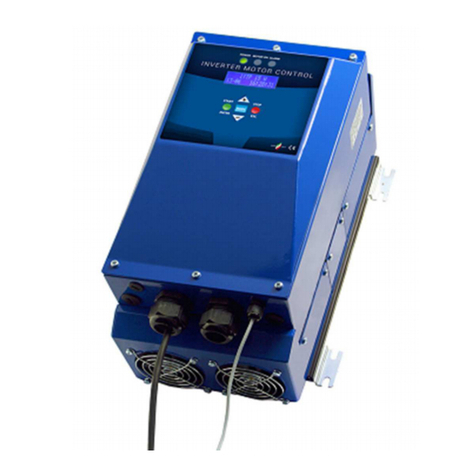
electroil
electroil ITTPD11W-RS-BC Operation and Maintenance Handbook
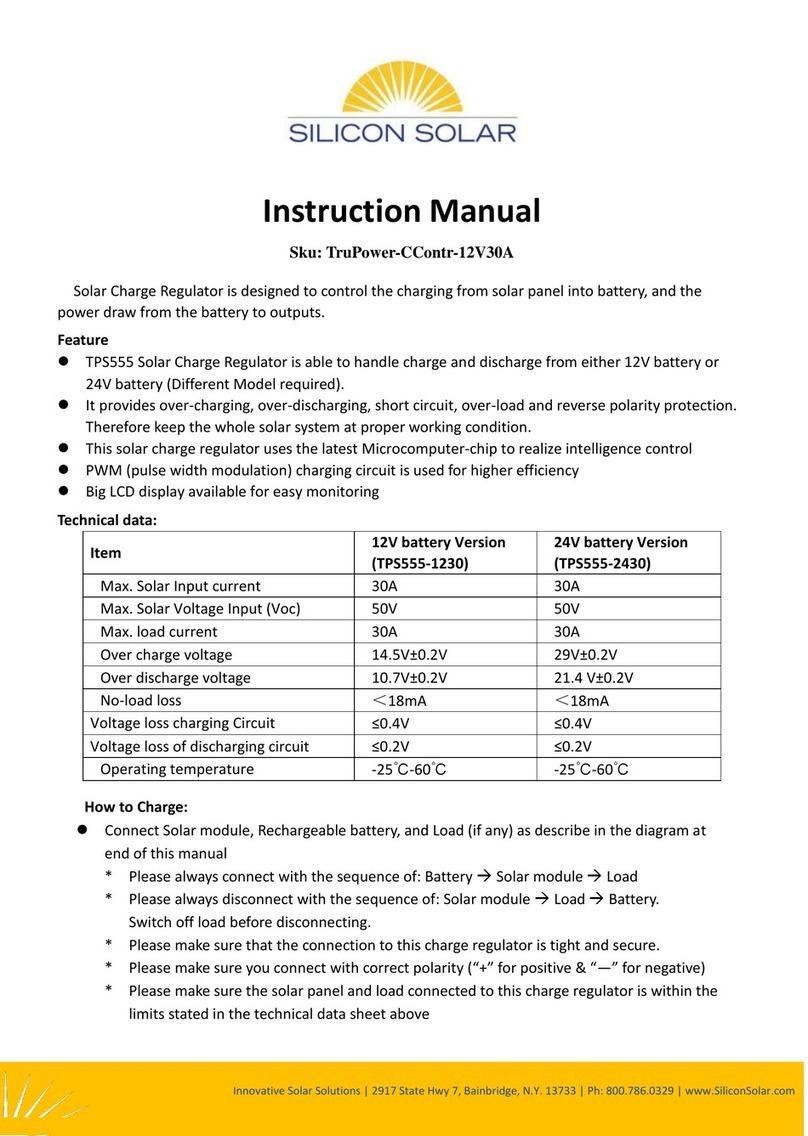
Silicon Solar
Silicon Solar TPS555-1230 instruction manual
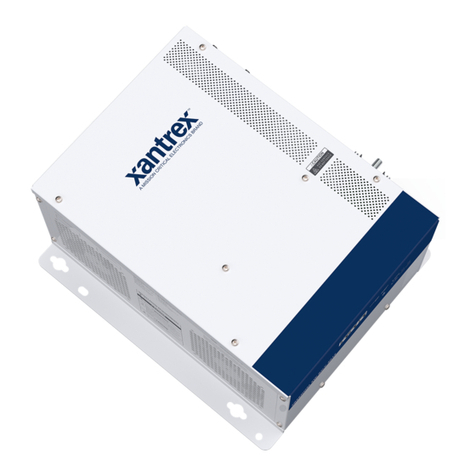
Mission Critical
Mission Critical Xantrex Freedom SW-RVC owner's guide
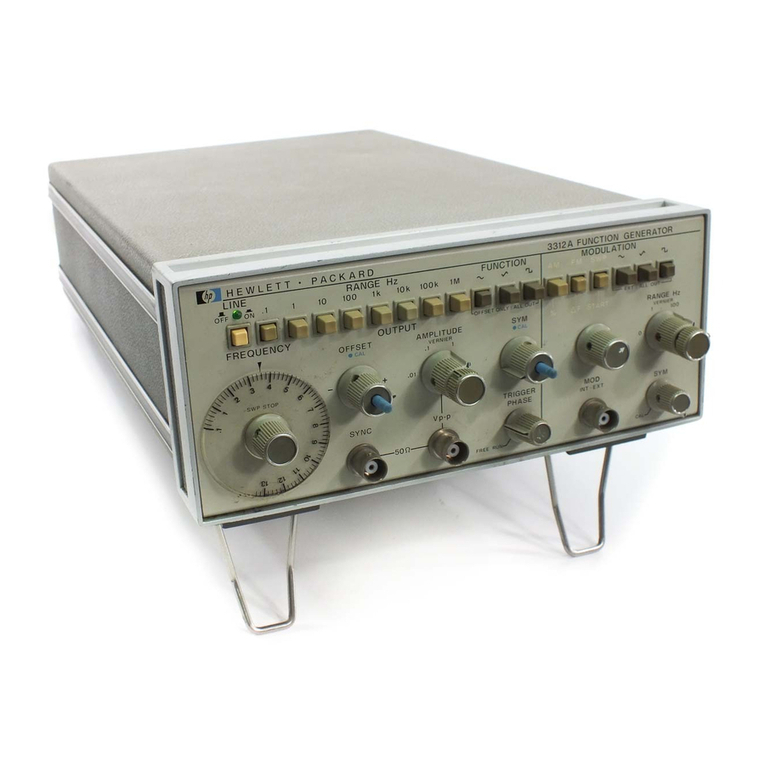
HP
HP 3312A Operating and service manual
